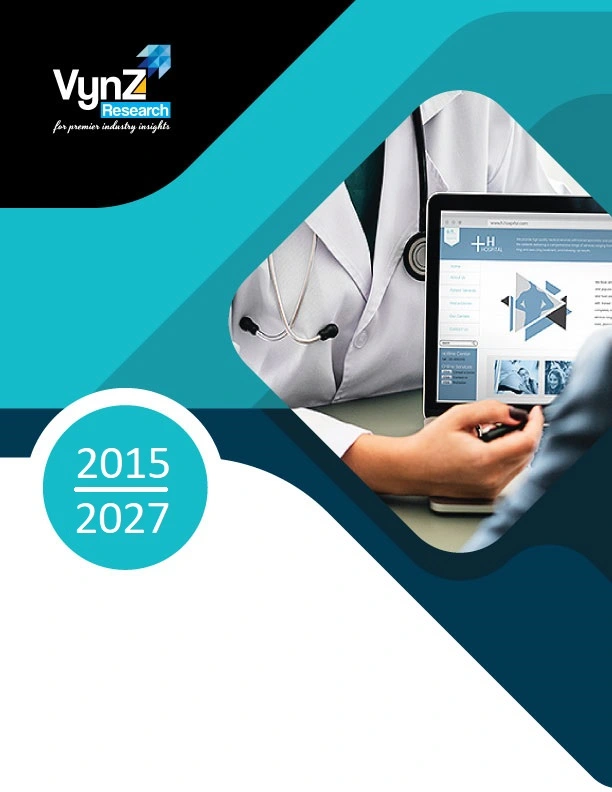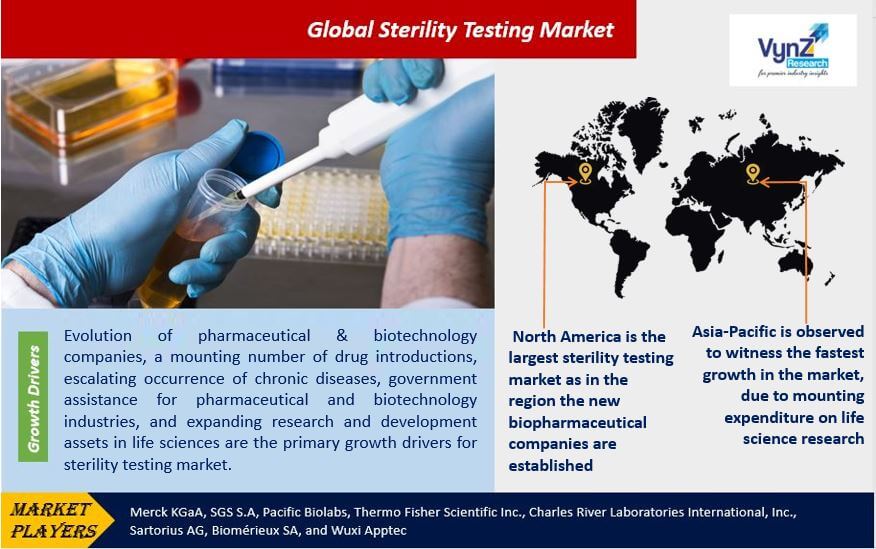| Status : Upcoming | Report Code : VRHC1074 | Industry : Healthcare | Available Format :

|

Global Sterility Testing Market – Analysis and Forecast (2025-2030)
Industry Insights by Product (Instruments, Kits & Reagents and Services), by Test (Membrane Filtration, Direct Inoculation, and Others), and by Application (Pharmaceutical and Biological Manufacturing, Medical Device Manufacturing and Others)
Industry Overview
The Global Pharmaceutical Sterility Testing Market is expected to grow from USD 1.59 billion in 2023 to USD 3.28 billion by 2030 at a compound annual growth rate (CAGR) of 11.02% during the forecast period ranging from 2025 to 2030.
Sterility testing refers to the process of finding out the lack or occurrence of viable microorganisms capable of growing under favorable conditions. Primarily, this test procedure helps in determining the impurities in biologics and medical devices.

The global sterility testing market is expanding at a rapid rate due to the development of pharmaceutical & biotechnology processes, rising the number of such companies, a significant increase in the number of drug introductions. The market comprises different products such as instruments, kits & reagents, and services out of which the kits & reagents will witness a higher demand in the following years due to a growing preference for kit-based testing and the rising need for frequent consumption of these products.
The significant hindrances to the market growth include the time-consuming process to get approvals as well as the lack of skilled professionals. The growing demand for such testing in the pharmaceutical industry due to higher efficiency and safety is offering significant growth opportunities to the market.
Market Segmentation
Insight by Product
The global sterility testing market is divided by product into instruments, kits & reagents, and services, where the kits & reagents segment will grow at a faster rate due to the need for frequent consumption, growing research and development activities, higher product affordability, rising prevalence, strict regulation of cGMP and cGLP, and growing incidents of drug-related adverse events due to product contamination. In addition, the instruments segment will also grow at a high CAGR due to technological development and better features to support low-pressure drops.
Insight by Test
The global sterility testing market is divided by tests into membrane filtration, direct inoculation, and others. Out of these the membrane filtration segment will grow more due to progress in the pharmaceutical and biotechnology industry, higher filtration efficiency, and technological developments in design and operations. Furthermore, the direct inoculation segment is also expected to grow at a fast rate due to its ability to be used in testing not filterable or deformable, and smaller volumes of test items.
Insight by Application
The global sterility testing market is divided by application into pharmaceutical and biological manufacturing, medical device manufacturing, and others. Out of all these segments, the pharmaceutical and biological manufacturing application segment is expected to grow at a higher rate due to significant progress in the pharmaceutical and biotechnology industry.
Insight by Sample
The global sterility testing market is divided by sample into pharmaceuticals, medical devices, and biopharmaceuticals. Out of them, the pharmaceutical segment is expected to contribute higher revenue due to higher volumes of testing and outsourcing sterility testing that helps them meet the strict regulatory requirements without high investments. On the other hand, the biopharmaceuticals segment is also expected to grow at a higher CAGR due to the rise in demand for biologics and biosimilar drugs, and high effectiveness in treating serious diseases like cancer, autoimmune diseases, neurological disorders, and more.
Insight by End Users
The global sterility testing market is divided by end users into compounding pharmacies, medical device companies, pharmaceutical companies, and others. Out of these segments, the pharmaceutical companies will grow more due to the significant rise in the demand for pharmaceutical products. The compounding pharmacies segment will also grow due to high standards of sterility, consistency, and lower risks.
Global Sterility Testing Market Report Coverage
|
Report Metric |
Details |
|
Historical Period |
2018 - 2023 |
|
Base Year Considered |
2024 |
|
Forecast Period |
2025 - 2030 |
|
Market Size in 2024 |
U.S.D. xx.x Billion |
|
Revenue Forecast in 2030 |
U.S.D. xx.x Billion |
|
Growth Rate |
x.x% |
|
Segments Covered in the Report |
By Product, By Test and By Application |
|
Report Scope |
Market Trends, Drivers, and Restraints; Revenue Estimation and Forecast; Segmentation Analysis; Impact of COVID-19; Companies’ Strategic Developments; Market Share Analysis of Key Players; Company Profiling |
|
Regions Covered in the Report |
North America, Europe, Asia-Pacific, Middle East, South America and Rest of the World |
Industry Dynamics
Industry Trends
There are several government initiatives noticed in the global sterility testing market that is shaping the healthcare landscape along with the financial support provided that is influencing the development & implementation of advanced sterility testing procedures within the pharmaceutical sector. innovative solutions and rising innovations are also a noticeable trend that is facilitating new product launches frequently. Services are also outsourced extensively to cope with the rising pressure and prices. Also, competitive strategies among competitors to position themselves effectively are noteworthy trends.
Growth Drivers
The primary growth factor of the global sterility testing market is the rising incidents of chronic diseases as well as the government assistance for pharmaceutical and biotechnology industries. In addition, the rising research and development assets in life sciences and activities are also propelling the growth of the sterility testing market. Some other major factors that influence market growth include the rise in pharmaceutical outsourcing, rising healthcare expenditure, and rapid technological developments in the field of sterility testing. Also, the growing government investments and development and launch of more effective drugs and the rising emphasis on quality & sterility are contributing to the growth of the market significantly.
Challenges
Entry of new players in the global sterility testing market is prevented due to the high capital requirement and strict regulatory standards. This prevents widespread market expansion. In addition, the stringent policies and standards for quality control for the development of comprehensive sterility testing procedures are also posing significant challenges to the market growth.
Opportunities
The higher demand for compliant solutions due to strict regulations as well as the expansion of biotech offers significant growth opportunities to the global sterility testing market. Rapid tech development and innovation, automation, emerging healthcare infrastructure, outsourcing sterility testing to contract testing services, increasing government investments and R&D activities, and changes in global healthcare trends are offering novel growth avenues to the market as well.
Geographic Overview
North America holds the largest share of the market due to the large number of established biopharmaceutical companies, higher research and development activities by the pharmaceutical and biotechnology industries, growing need for sterility testing, rising healthcare expenditure, higher adoption and acceptance, and the existence of an active healthcare system.
The Asia-Pacific market will also grow at a higher CAGR due to rising expenditure on life science research, rising number of biopharmaceutical manufacturers, higher occurrence of chronic diseases, favorable regulatory environment, and a higher preference for pharmaceutical outsourcing.
Competitive Insight
Key players in the sterility testing market are catering to the demand for these devices by investing in technologically advanced products in their product portfolio across the globe. Merck KGaA, SGS S.A, Pacific Biolabs, Thermo Fisher Scientific Inc., Charles River Laboratories International, Inc., Sartorius AG, Biomérieux SA, and Wuxi Apptec are the key players offering sterility testing products.
The Merck Group commonly known as Merck, is a German multinational science and technology company headquartered in Darmstadt. The company is divided into three business lines: Healthcare, Life Sciences, and Electronics.
SGS is a Swiss multinational company headquartered in Geneva, which provides inspection, verification, testing, and certification services.
Recent Developments by Key Players
SGS has been awarded the Metro de Madrid S.A. framework agreement Technical Attendance for Operational Railway Safety of Technical, Operational, or Organizational Modifications of Madrid Railway System. With a center of excellence based in Madrid, SGS is accredited by ENAC, the Spanish accreditation entity, as a Notified Body (NoBo), Designated Body (DeBo), and Safety Assessment Body (ISA/AsBo) for all railway subsystems.
Merck KGaA, based in Darmstadt, Germany has introduced the M-Trace Software & Mobile App that is designed to digitize sterility testing in microbial quality control. The offering focus on enhancing process safety by automatically documenting each step of the testing workflow, thereby minimizing deviations, false positives, and human error.
The Sterility Testing Market report offers a comprehensive market segmentation analysis along with an estimation for the forecast period 2025–2030.
Segments Covered in the Report
- By Product
- Instruments
- Kits & Reagents
- Services -
- By Test
- Membrane Filtration
- Direct Inoculation
- Others
- By Application
- Pharmaceutical and Biological Manufacturing
- Medical Device Manufacturing
- Others
Region Covered in the Report
- North America
- U.S.
- Canada
- Mexico
- Europe
- Germany
- U.K.
- France
- Italy
- Spain
- Russia
- Rest of Europe
- Asia-Pacific (APAC)
- China
- Japan
- India
- South Korea
- Rest of Asia-Pacific
- Rest of the World (RoW)
- Brazil
- Saudi Arabia
- South Africa
- U.A.E.
- Other Countries
.png)
Source: VynZ Research
.png)
Source: VynZ Research
Frequently Asked Questions
Purchase Options
Latest Report
Research Methodology
- Desk Research / Pilot Interviews
- Build Market Size Model
- Research and Analysis
- Final Deliverabvle
Connect With Our Sales Team
- Toll-Free: 1 888 253 3960
- Phone: +91 9960 288 381
- Email: enquiry@vynzresearch.com
Sterility Testing Market
